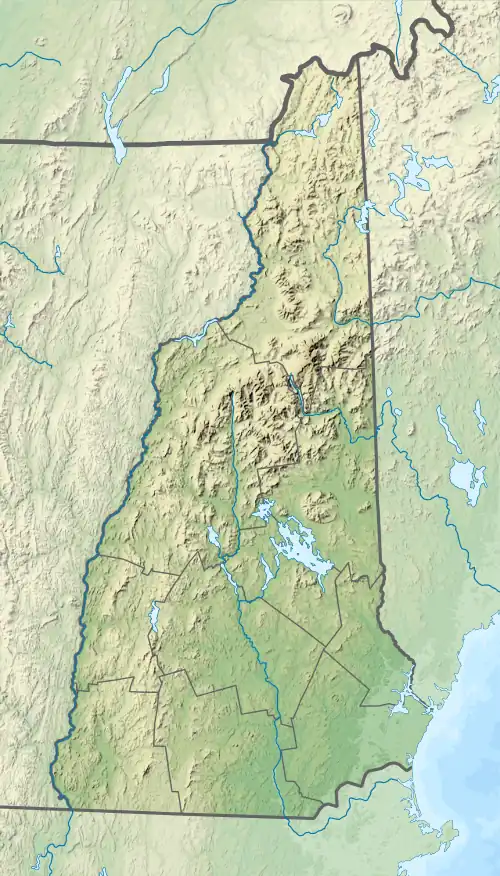Wallis Sands State Beach
Wallis Sands State Beach is a public recreation area located on the Atlantic Ocean in the town of Rye, New Hampshire. The state park offers a sandy beach with bathhouse, picnicking, and 500-car pay-parking lot.[4][5]
| Wallis Sands State Beach | |
|---|---|
 | |
 Location in New Hampshire | |
| Location | 1050 Ocean Blvd., Rye, New Hampshire, United States |
| Coordinates | 43°01′40″N 70°43′44″W |
| Area | 30 acres (12 ha)[1] |
| Elevation | 0 feet (0 m)[2] |
| Designation | New Hampshire State Park |
| Established | 1964[3] |
| Administrator | New Hampshire Division of Parks and Recreation |
| Website | Wallis Sands State Beach |
History
- Coastal station
During the 19th century[6] and early 20th century,[7] Wallis Sands was a Life-Saving Station of the United States Life-Saving Service and subsequently was a station of the United States Coast Guard.[8] The station was discontinued around 1938.[9]
- State park
The first parcel of the future state park, about one acre in size, was purchased by the state in 1901. That fragment was used as a wayside park in the 1950s. Following expansion of its footprint to 18 acres (7.3 ha) and the construction of jetties to protect an enlarged beach area, Wallis Sands State Park was opened to the public in June 1964.[3]
- Jellyfish incident
In July 2010, nearly 150 beachgoers and swimmers were stung here on the same day by a lion's mane jellyfish. Most were treated on site with vinegar, and several children were taken to a hospital. A lifeguard had pitchforked a 40-pound (18 kg) jellyfish – whose longest tentacle was 13 feet (4.0 m) – to try to drag it ashore and dispose of it; however, the dead jellyfish broke apart, releasing its nematocysts on the beach and stinging the crowd in the span of about 20 minutes.[10][11]
References
- "State Lands" (PDF). New Hampshire Department of Resources and Economic Development. July 2007. Retrieved October 3, 2020.
- "Wallis Sands State Park". Geographic Names Information System. United States Geological Survey, United States Department of the Interior.
- Lisa Mausolf, Preservation Consultant (March 2019). "New Hampshire State Parks: Mid-Century Modern (1945-1975): Historic Context Study" (PDF). New Hampshire Division of Parks and Recreation. p. 130. Retrieved October 3, 2020.
- "Wallis Sands State Beach". New Hampshire Division of Parks and Recreation. Retrieved October 3, 2020.
- "Beaches & State Parks". Hampton Beach Village District. Retrieved October 3, 2020.
- President Benjamin Harrison (1891), W. H. Michael (ed.), The Abridgment, 1891. Containing the annual message of the President of the United States to the two Houses of Congress. 51st Congress, 2nd Session. With reports of departments and selections from accompanying papers., Washington: United States Government Printing Office, p. 80, OCLC 145402605.
- Ogden, Herbert Gouverneur; Ross, John; Graves, Herbert C.; U.S. Coast and Geodetic Survey (1903), United States Coast Pilot: Atlantic Coast: Section A., St. Croix River to Cape Cod, Washington: United States Government Printing Office, p. 26, OCLC 29093903.
- U.S. Coast Guard (1915), Annual report of the United States Coast Guard for the fiscal year ended June 30, 1915, Washington: United States Government Printing Office, p. 73, OCLC 21049242.
- U.S. Coast Guard History Program: Station Wallis Sands, New Hampshire, Coast Guard Station #13
- "Dead jellyfish stings about 150 beachgoers in New Hampshire". CNN. July 22, 2010.
- "How One Jellyfish Stung 100 People". Live Science. July 22, 2010.
External links
- Wallis Sands State Beach New Hampshire Department of Natural and Cultural Resources